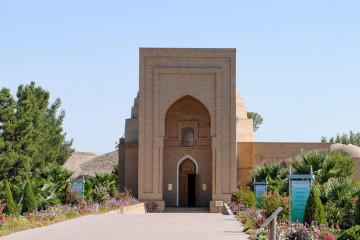
IMAM AL-BUKHARI
The real name of Imam al-Bukhari was Muhammad, his title was Abu Abdullah, and sometimes he was called “Imam al-muhaddisiyn” meaning the leader of the science in Hadiths, sometimes he was glorified as “the king of the science in Hadiths”. His family name was Muhammad ibn Ismail ibn Ibrahim ibn al-Mugiyra ibn Bardizbah ibn Bazazbeh. As is seen from the two last names, the ancestors of Imam al-Bukhari belonged to the Ajams, the non-Arab inhabitants of Bukhara, and the word “Bardizbah” means in Arabic a man who is engaged in agriculture.
Imam al-Bukhari’s father was Ismail whose title was Abul Hasan. He was an educated muhaddis2 and one of the followers of Imam Malik who was the founder of the Malikiya teachings and one of the well-known representatives of the science in Hadiths. Abul Hasan was also engaged in trade. It is a pity that we do not have at our disposal any written work by him, but we have some information from different sources that he was in close connection with such well-known scientists of their time as Hamid ibn Zaid, Imam Malik and Abu Muaviya and presented some Hadiths from the conversations with them. He is also known to have been taught by Abdullah ibn al-Mubarak. He had some followers from Iraq such as Ahmad ibn Hafs, Nasr ibn Husain and some others. In the book titled “Al-Tarikh al-Kabir” (Big History), Imam al-Bukhari gave some important information about his father’s biography. A historian of that time Al-Hafiz ibn-Hibban mentioned in his book “Kitab-as-siqqot” (A book about great people) that Ismail ibn Ibrahim, that is to say, Imam al-Bukhari’s father used to present Hadiths from Hamad ibn Zaid and Imam Malik and these Hadiths were taken by the scientists from Iraq to be further developed.
Imam al-Bukhari paid greater attention to the positive and model peculiarities of the roviys of Hadiths. If the meaning and the idea of a Hadith was rightful and correct, he used to describe the characteristic features of the roviys of that Hadith.
As the written resources inform us, during his creative activity Imam al-Bukhari wrote more than twenty books. They are as follows: “Al-Jami as-Sahih”, “Al-Adab al-mufrad”, “Kitab al-kunaa”, “Kitab al-favayid”, “Juz raf al-yaddayin”, “At-Tarikh al-kabir”, “At-Tarikh al-avsat”, “At-Tarikh as-saghiyr”, Al-Jami al-kabir”, “Khalq af’al al-ibad”, “Kitab az-zuafa as-saghiyr”, “Al-Musnad al-kabir”, “At-Tafsir al-kabir”, “Kitab al-heeba”, “Asamiy as-Sahaba”, “Kitab ul-vuhdan, “Kitab al-mabsut”, “Kitab al-ilaal”, “Birr al-validayin”, “Kitab al-ashribati”, “Qazaya as-Sahaba va at-tabiiyn”, “Kitab ar-Riqaq”, “Al-Jami as-saghiyr fil-Hadith”, “Al-Qiraatu khalf al-Imam”.
Al-Bukhari’s contemporaries and colleagues of the same age with him were such famous figures of that time as Imam Abu Zur’a ar-Razi, Abu Hatam ar-Razi, Ibrahim al-Harbi, Abdullah ibn Mutiyn, Is’haq ibn Ahmad ibn Ziyrak al-Farsi, Abu Bakr Muhammad ibn Is’haq ibn Khaziyma, al-Qasim ibn Zakariyya, Muhammad ibn Abdullah al-Khadrami, Muhammad ibn Qutayba, Abu Bakr al-A’yin and others. They unanimously acknowledged the deepness and great amount of al-Bukhari’s knowledge in the science of Hadiths. These people were well-known scientists in the field of Hadiths, history, law and other branches of the Islamic science.
✍️Farrukh Sadullaev- Deputy director of International scientific-research centre of Imam Tirmizi
 УЗ
УЗ
 РУ
РУ
 EN
EN
 العربية
العربية






Оставить комментарий